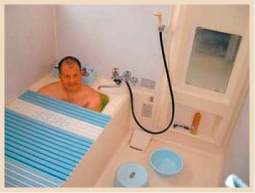
Todd Jay Leonard, Blog


Continuing on with my series of favorite things about Japan, No. 6 on the list is the "ofuro" or Japanese bath.
Few things in life are as satisfying and luxurious as a traditional Japanese bath. Over the millennia, Japan and its people have truly perfected bath-taking - elevating a mundane process of daily hygiene into a veritable art form, one that is steeped in ritual and, in my opinion, could be regarded as a precious and treasured cultural asset of Japan.
Many first-time visitors to Japan are a tad apprehensive about two aspects of taking a Japanese bath: entering bath water that has been used by someone else; and bathing with strangers in communal or public baths.
Admittedly, on my first visit to Japan as a 17-year-old high school student, I, too, was not very keen about baring it all with a group of strangers or getting in a tub after several people had already used it.
However, after just one time, I was hooked. All apprehensions were cast aside, and I am now a big fan of all types of traditional Japanese baths: the home bath, communal or public bath and the hot spring baths known as "onsen" in Japanese.
It is necessary to keep in mind that the Japanese bathtub is not used in the same way people use a bathtub in the United States. The Japanese bathtub is used only for soaking and not washing. The water is clean and steamy hot - so blistering sometimes that it seems like it's going to scald your skin.
So in reality, one is not really bathing in the true sense of the word, meaning splashing about in soapy, dirty water as is the custom in the West. The Japanese bathtub is used only for soaking and relaxing, similar to a hot tub's intended use, except without swimming trunks and massaging bubbles.
I tend to be much more apprehensive about getting into a hot tub than I am about entering a Japanese bath, because before entering the actual bathtub, proper Japanese etiquette obliges the bather to first thoroughly soap, scrub, and rinse off their bodies before setting foot into the hot water.
Most people enter a hot tub without bathing, knowing that so much chlorine is in the water that, like a pool, a shower afterward is needed.
From early childhood, Japanese children are exposed to traditional Japanese baths and learn early on how properly to wash their bodies. In Japanese families, children's bath time is nearly always done with Dad.
From the time the children are babies, Dad is the one who usually bathes with the children giving Mom a short break after dinner. Most every adult Japanese person can pull out a photo with Dad in the bathtub, usually as a small baby, taken by Mom. This custom of children bathing with Dad continues until they reach an age when they can bathe alone.
All in the family
As a family outing, many Japanese families will visit a public or natural hot spring bath on the weekend. Some newer and more modern public bath facilities offer a "family bathroom" where an entire family can bathe together in privacy - mother, father and children.
Quite numerous in the old days, mixed public baths (that allowed both men and women to bathe together) are not so common today. The Christian missionaries who came to Japan in the late 1800s tried very hard to nix this custom and eventually were largely successful except for traditional "onsen" that often feature several outdoor baths called "rotenburo." A number of these allow both men and women to bathe together still today.
When friends visit from home, I like to take them to my favorite traditional-style "onsen" in the mountains that offers a variety of baths, including a communal outdoor bath that is mixed.
This particular bathhouse is actually a traditional Japanese inn. It is located so far away from civilization that it has no electricity. Cell phones are unable to pick up any signal. For travelers wanting to truly get away from it all, this is the place to go for total relaxation, away from the clutches of modern technology. At night, oil lanterns are lit all around the inn and the surrounding grounds, giving it a magical and surreal appearance.
In the summer, guests scurry from bath to bath in their cotton "yukattas" (summer kimonos) enjoying all the various baths, each boasting different health benefits. The mineral water in these baths is well-known around the country for its medicinal value that helps relieve chronic conditions such as arthritis.
The bathers first bathe inside with soap to clean their skin before going outside to try out all of the different baths located around the inn.
Outside in the wintertime
In the winter, the only way to access this inn is by snowmobile. Upon arrival, special winter kimonos are offered to guests; these are thicker, giving people a semblance of warmth as they go from bath to bath.
Guests learn to disrobe quickly in the cold weather, plopping themselves down in the immediate warmth of the outside baths. It is indeed serene to sit quietly, enjoying the winter snow falling gently upon your head.
Japanese, as a people, are very modest, so a small towel is used to cover the important parts as one enters and exits the bath. There are wall-less stations all around the periphery of the bathroom equipped with a small wall mirror that each person uses while bathing.
Bathers sit on small stools, low to the ground, utilizing a small washpan for rinsing the soap off their bodies. Even though the next person is only inches away, one has a feeling of being alone.
Really self- or body-conscious people may find a Japanese public bathing experience to be much too torturous to bear; but in fact, it is such a common and natural part of Japanese people's lives that no one pays other bathers much attention. Perhaps by sitting low to the ground and in front of this small mirror, psychologically it gives one a sense of privacy. After all, it would be rude to stare and besides, everyone is in their birthday suits, so what's the big deal?
For the shy and uninitiated, perhaps the privacy of a home bath would be best to try first before bathing in a communal bath. Home baths are typically wide and deep, allowing bathers to submerge up to their necks.
No worries
The most wonderful part about a Japanese bathroom is that bathers don't have to be careful about splashing water about, because the entire room is water-resistant. The walls, ceiling and floor can be sprayed with water without worry.
Also, the shower nozzle is not attached to the wall - it can be detached to rinse your body and hair while sitting or standing. This also makes cleaning the bath quite easy. Little, plastic boots are sold at supermarkets that can be worn while scrubbing down the bathroom.
In fact, there are a number of interesting bath-related accessories that people buy for the bath. A cover is used between bathers to keep the water hot; and in the winter, it helps to hold the heat in the bathtub while the person is bathing, because the typical bathroom is unheated.
A stir-stick is used for non-temperature-controlled baths to make sure the hot water is evenly distributed. A bucket and stool - as well as a smaller. ladle-like container - are used for the actual body-washing portion of the bath. A long and narrow washcloth is used for scrubbing the skin. Its rough texture reminds me of sandpaper, and it basically has the same effect.
These rough washcloths exfoliate, sloughing off dead skin cells from the body. This keeps the skin smooth and silky. Since many Americans opt for a morning shower, forgoing the use of any type of washcloth, they are only washing off the dirt and grime for the most part and not all of the dead skin cells.
Generally, Japanese people have beautiful skin, often resembling silk. I believe this has a lot to do with the bath ritual they perform daily. I am always amazed at how thorough people are, even children, when bathing at a public bath. Children scrub and scrub their little bodies with such determination, learning by observing and mimicking their parents.
I still insist upon a morning shower, because this is a part of my culture. In addition, though, I relish taking a luxurious and relaxing Japanese bath before bed. The best of both worlds.
By TODD JAY LEONARD
Columnist
Cultural boon
Japanese bath ‘Ofuro’ offers best of both worlds
Monday, June 18 , 2007







